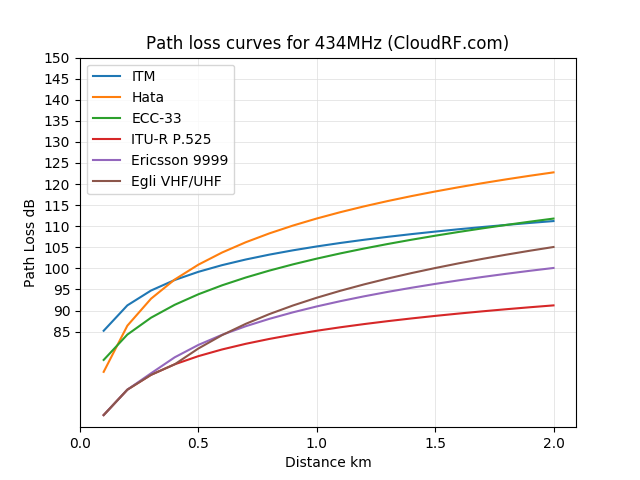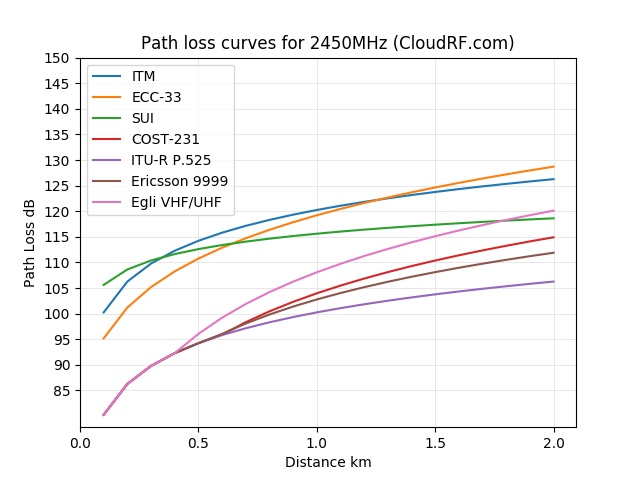This service offers a variety of propagation models for different purposes. For maximum speed the models are all written in a low level language (C++). Feedback from radio professionals and developers is encouraged to optimise the models where possible.
ModelDescriptionFrequency range
| Irregular Terrain Model (ITM) | ‘Longley Rice’ Model. US Gov. general purpose model used by FCC | 20-20,000MHz | Line of Sight (LOS) | Simple model for viewing obstructions | Okumura-Hata | Hata model for cellular communications in urban areas | 150-1500MHz | ECC33 (ITU-R P.529) | ECC33 model for cellular and microwave communications | 700-3500MHz | Stanford University Interim (SUI) | SUI model for WIMAX communications | 1900-11000MHz | COST231-Hata | European COST231 frequency extension to Hata model for urban areas | 150-2000MHz | ITU-R P.525 | Free Space Path Loss model | 20-100,000MHz | Ericsson 9999 | Ericsson 9999 model for cellular communications up to 1900MHz | 150-1900MHz | Egli VHF/UHF | General purpose VHF/UHF model. More conservative than FSPL | 30-1000MHz |
Find your perfect model
We’ve pre-computed path loss curves for all supported frequencies within our API so you can compare models. Models with high attenuation are conservative and models with low attenuation are optimistic.
Explore path loss curves
 |
 |
 |
 |
Irregular Terrain Model
This service uses the Irregular Terrain Model version 7, also known as the ‘Longley Rice’ model.
The ITM model is a long standing general purpose model developed by the US NTIA and used by the FCC which meets most radio engineering requirements for frequencies between 20 MHz and 20 GHz. It is suitable for everything RF from handheld VHF walkie-talkies to SHF microwave links. It factors in electromagnetic theory, terrain features, ground clutter, diffraction and radio measurements to predict the attenuation of a radio signal at a given point on the earth.
With the addition of reliability (time and situations) as a percentage the model can be tuned to be compliant with TSB-10 (Revision F) standards for microwave communications which defines a reliability of 80% for a long term loss and 99% for a short term loss.
Line of Sight (LOS) model
The LOS model is a simpler model well suited to super high frequency microwave links where LOS is key. It factors in terrain data and antenna heights to provide a clear yes/no result. It starts where the ITM model finishes at 20GHz and extends the maximum range up to 100GHz.
Okumura-Hata models
The Hata models were designed for Urban cellular planning which is evident by their focused frequency range (150-1500MHz) and minimum tower elevation of 30m. The model assumes the transmitter is higher than the average height of the rooftops.
COST231-Hata extension
The COST231-Hata model extends the Hata cellular models another 500MHz up to 2000MHz so is well suited to GSM1800 in urban areas.
ITU-R P.525 Free Space Path Loss
The free space model is a very simple model that assumes no obstacles exist between transmitter and receiver. It factors in the frequency and distance. It can be further enhanced with the addition of knife edge diffraction which will factor in terrain obstacles and antenna heights.
ITU-R P.529 ECC33
ECC33 model for cellular and microwave communications covering 700-3500MHz
Egli VHF / UHF
General purpose VHF / UHF model for 30MHz to 1000MHz. It is more conservative than FSPL but more optimistic than Hata/COST.
Knife edge diffraction
In their native form, the empirical models (Hata, COST, ITU-R P.525) do not factor in the significant effects of diffraction caused behind obstacles. To accommodate this without the processing overhead associated with recognised complex diffraction theories, a proprietary knife edge diffraction function has been written which simulates modest diffraction, varied by wavelength and the angle of the received point to the obstacle summit.

